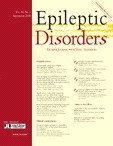Jiruska P, Marusic P, Jefferys JG, Krsek P, Cmejla R, Sebronova V, Komarek V. Epileptic Disord. 2011 Mar;13(1):76–81. IF: 1.198

Abstract:
Sturge-Weber syndrome is a neurocutaneous disorder classically characterized by the presence of facial port-wine stain and ipsilateral leptomeningeal angiomatosis. It is often associated with refractory epilepsy which requires surgical treatment. We present a case of a patient who initially presented with partial seizures of temporo-occipital origin, ipsilateral to the pial angiomatosis. During the course of the disease, the patient developed medically refractory epilepsy with partial seizures originating predominantly from the contralateral temporo-occipital area as well as myoclonic and myoclonic-astatic seizures. Resection of the occipital and temporal lobe affected by the pial angioma resulted in favourable outcome. Bilateral dysfunction observed in Sturge-Weber syndrome may result in an increased capability of focal discharges to generate synchronous epileptiform activity leading to an increased incidence of generalised seizures, most probably via a mechanism of secondary bilateral synchrony.
-im-